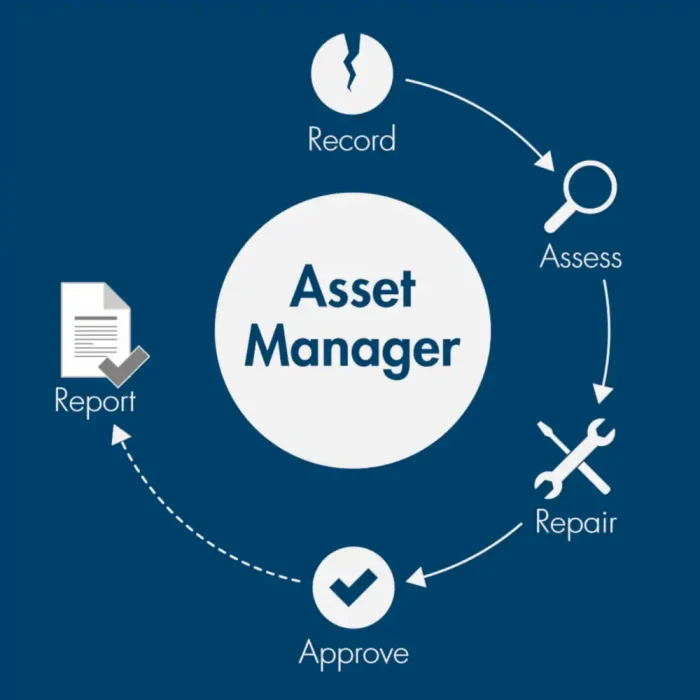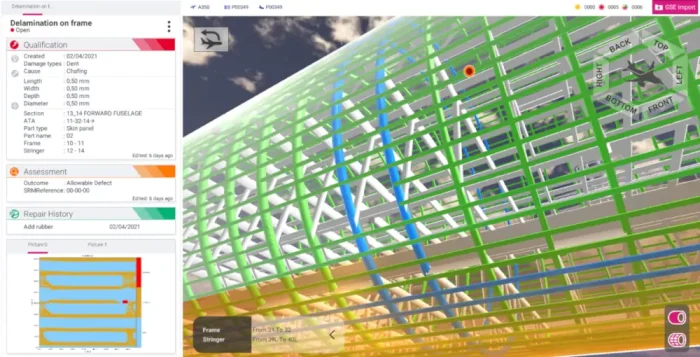AssetManager is a monitoring software, provided by Testia, that makes Airbus’ “3D Repair” available to customers from all industries. Learn more about the features and benefits of this solution in the following interview with the product owners.
Imagine that you can monitor any of your assets remotely during its whole service life. You would have a digital twin that shows all the information about the actual asset – just as if a model plane would be a live copy of the one in the air.
This works for aircrafts, ships, wind farms, chemical plants industrial machines and any other asset. With Testia’s AssetManager!
We at Testia strive to develop solutions for boosting efficiency and generate value for our customers.
Nowadays, industrial asset operators worldwide face similar challenges across all businesses:
- Difficulties to detect and repair damages
- Problems to trace many different events in real-time
- Lack of constant monitoring for all assets worldwide
Testia’s AssetManager provides an answer to this complexity. This platform based on Airbus’ 3D Repair has been tested in the aerospace industry and we adopted it for use in other industry sectors.
It is a cloud solution that provides central access of key information to everyone involved in your maintenance and inspection processes: Quick and precise access to recording, assessing, monitoring and reporting of structural damages.
Main features of 3D Repair / Asset Manager
Guillaume Ithurralde, Chief Technical Officer of Testia, has discussed the features and benefits of AssetManager with two colleagues:
Nicolas Brimont, product owner of AssetManager at Testia
and Rajib Dey, product owner of eTech 3D Repair – Airbus’ software that is the base of AssetManager.
You can watch the discussion as a video on YouTube or read the interview text below:
Guillaume: We will discuss first how the platform developed by Airbus solves a variety of issues for aerospace; and second how Testia’s AssetManager opens up these possibilities for assets from all industry sectors.
Can you give us an overview of the software, Rajib?
Rajib: Sure. Since you talked about the variety of issues, let me go back and explain the typical way of managing structural damages. Basically, what happens during a structural damage management is this: Mechanics record the information on paper, using physical tools during the manual inspection, and then they go and hand it to the engineers. Engineers on the other hand asses the damages by going through huge repair manuals or sometimes by contacting the OEMs. And sometimes we even need to generate reports for the authorities or for the pilots.

So, what Airbus realized at this point is that we can improve the efficiency by connecting all these actors together. And that was when 3D Repair was conceptualized and it is aiming to create a single source of truth for all these actors, providing an aircraft-centric view enabled by a digital twin.
If you want me to talk about the various benefits that Airbus 3D Repair offers, I would say it is fleet-agnostic: Any fleet, coming from any manufacturer can be managed using the software. It is a mobile solution, so it can be used with any handheld device, be it a Windows operating system or iOS. This ensures traceability at part-level from rear to nose of an aircraft: When the aircraft is coming out of the final assembly line (FAL), the damages that may have occurred during this FAL are also captured in 3D Repair.
We also have a direct link to Tech Request, so the engineers do not need to reproduce the damage information again in Tech Request. We have developed some generic APIs that connect the aircraft’s MIS system, so all the data are synched in real-time. Last but not least, this product is available for MROs, for airlines and even for leasing companies – it has a great potential for a larger audience.

Guillaume: Speaking of this larger audience, even outside aerospace – Nicolas, what does AssetManager add to the list of features?
Nicolas: It is good to know that AssetManager works with 3D models as a “digital twin”. This means, the software is not only suitable for aircrafts, but for basically every asset with an available 3D model, for example a ship or a wind turbine.
The app shows all damages on the 3D model and thanks to a color code, the users can directly see if a damage status is open, closed or even obsolete when the part has been replaced in the meantime. With this digital twin, creating and finding damages on the model is very easy, flexible and accurate.
AssetManager can also be combined with Testia’s NDT equipment ThicknessTool and LocateTool. These tools allow easy detection and assessment of the damage. After that, all this info can automatically be transferred to AssetManager. With that information, the app locates the damage on the 3D model accurately. This automatic and digital workflow is a real efficiency booster, because it saves time and reduces errors.
Traceability and Accessibility in real-time are at the core of the software
Guillaume: Information is key to compete in the industrial business environment. And data accessibility and accuracy are just the tip of the iceberg. In this context, how does our platform help to synchronize and centralize the critical data in real-time, Rajib?
Rajib: Indeed, I think that is where the product architecture plays a crucial role. As you know, it is a cloud-based application and all the data is centrally located and accessible for any actor in real-time.

Maybe I’ll take the opportunity to share the good news that we have recently integrated one of the electronic logbook systems. So you can imagine, the data is transferred from pilot to mechanics to engineers and potentially to authorities in real-time. Airbus’ 3D Repair also includes a notification-based mechanism to update all actors so they can react promptly. This is another factor to add efficiency.
We did some math for our maintenance economics and we found that 3D Repair can improve efficiency up to 60 %! And I am talking about only the tangible benefits on some of the axes like time savings, process efficiency, reschedule value – and maybe the whole ecosystem, because our application is fleet agnostic.
Guillaume: Now, how exactly does this synchronization impact the workflow of the various users within AssetManager, Nicolas?
Nicolas: In order to synchronize the maintenance workflow, AssetManager allows different user roles. For example, a mechanic can take action by recording a damage on the asset while an operator will do the assessment.
A user cannot miss out any information on a damage, because every one of them is tracked and shown to all relevant users in the workflow.
The data is shared via a cloud server. This means: No more emailing or even printing, because all data is available digitally in the app to all inspectors, mechanics, operators etc. Finally, AssetManager can automatically generate reports in many different formats. These reports provide an exact picture of the current state of your asset.
So, to sum it up: AssetManager is the perfect tool to manage your asset through the whole service lifecycle.
For more information visit our dedicated AssetManager product page or contact us directly.

